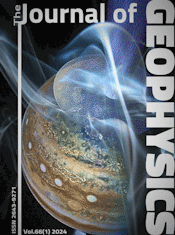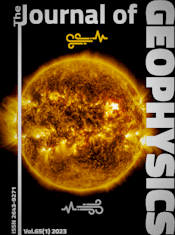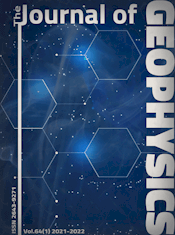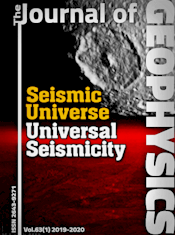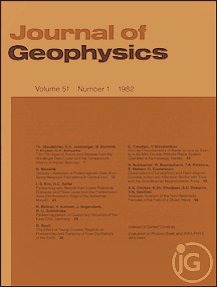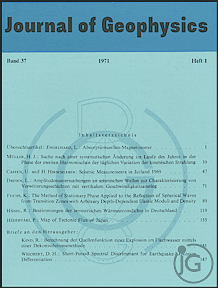Amplitude study of the Pg phase
Article Sidebar

Vols. 1-18 (1924-1944), ISSN 0044-2801
Main Article Content
Abstract
The amplitude of the Pg phase, as recorded in explosion seismology studies, is analyzed with the aid of synthetic seismograms. Parameters such as source frequency, low-velocity cover above the crust (sediments or weathered layer), low-velocity layers within the upper crust, velocity gradients, thickness of the gradient zone, attenuation and Poisson's ratio strongly influence the amplitude-distance pattern of the Pg phase. A systematic study clearly shows that different models of the continental upper crust display distinct amplitude-distance characteristics. These models could not be distinguished by travel-time interpretation alone. In the presence of gradient zones the amplitude-distance curve shows different patterns depending on the source frequency. The higher the frequency, the more pronounced are the relative maxima in the amplitudes. The presence of a low-velocity cover at the surface accentuates the character of the amplitude-distance curves even if the cover is thin (a few hundred meters). Moreover, a low-velocity cover produces P to S conversions and multiples following the Pg which obscure possible secondary crustal phases. The thickness of the velocity gradient zone influences the amplitude decay and the width of the relative maxima. Low-velocity layers within the upper crust cause a faster drop-off of the amplitudes than would be expected from ray theory. Detailed Pg amplitude studies are thus useful in improving the knowledge of the physical properties of the upper continental crust. The application of the derived criteria to two sets of real data allow us to determine fine details of the velocity-depth function which are of great importance for the understanding of the Earth's crust.
 ARK: https://n2t.net/ark:/88439/y083748
ARK: https://n2t.net/ark:/88439/y083748
Permalink: https://geophysicsjournal.com/article/291
Article Details
References
Banda, E., Ansorge, J. (1980) Crustal structure under the central and eastern part of the Betic Cordillera. Geophys. J. R. Astron. Soc. 63:515-532
Bath, M. (1974) Spectral Anaysis in Geophysics. Elsevier, Amsterdam
Boigk, H., Schoeneich, H. (1968) Die Tiefenlage der Perm basis im noerdlichen Teil des Oberrheingrabens. In: Illies, J.H., Mueller, St. (Eds.) Graben Problems, pp 45-55. Stuttgart: Schweizerbart'sche Verlagsbuchhandlung
Born, M. (1933) Optik. Springer, Berlin
Braile, L.W., Smith, R.B. (1975) Guide to the interpretation of crustal refraction profiles. Geophys. J. R. Astron. Soc. 40:145-176
Braile, L.W. (1977) Interpretation of crustal velocity gradients and Q structure using amplitude-corrected seismograms. In: The Earth's crust. Am. Geophys. Union Monogr. 20v427-439
Braile, L.W., Smith, R.B., Ansorge, J., Baker, M.R., Sparlin, M.A., Prodehl, C., Schilly, M.M., Healy, J.H., Mueller, St., Olsen, K.H. (1982) The Yellowstone-Snake River Plain seismic profiling experiment: Crustal structure of the Eastern Snake River Plain. J. Geophys. Res. 87:2597-2610
Buechi, U.P., Lemcke, K., Wiener, G., Zimdars, J. (1965) Geologische Ergebnisse der Erdoelexploration auf das Mesozoikum im Untergrund des schweizerischen Molassebeckens. Bull. Ver. Schweiz. Petrol. Geol. Ing. 32(82):7-38
Chapman, C.H. (1978) A new method for computing synthetic seismograms. Geophys. J. R. Astron. Soc. 54:481-518
Červeny, V. (1966) On dynamic properties of reflected and head waves in n-layered Earth's crust. Geophys. J. R. Astron. Soc. 11:139-147
Červeny, V. (1979) Accuracy of ray theoretical seismograms. J. Geophys. 46:135-149
Červeny, V., Molotkov, LA., Pšenčik, I. (1977) Ray method in seismology. Charles University Press, Prague
Fauria, T.J. (1981) Crustal structure of the Northern Basin and Range and Snake River Plain: A ray-trace travel-time interpretation of the Eureka, Nevada, to Boise, Idaho, seismic refraction profile. M.S. Thesis, Purdue University
Fuchs, K. (1968) The reflection of spherical waves from transition zones with arbitrary depth-dependent elastic moduli and density. J. Phys. Earth 16:27-41 (Spec. Issue)
Fuchs, K., Muller, G. (1971) Computation of synthetic seismograms with the reflectivity method and comparison with observations. Geophys. J. R. Astron. Soc. 23:417-433
Gebrande, H. (1976) A seismic-ray tracing method for two-dimensional inhomogeneous media. In: Giese, P., Prodehl, C., Stein, A. (Eds.) Explosion seismology in central Europe, pp. 162-167. Springer, Heidelberg
Healy, J.H. (1963) Crustal structure along the coast of California from seismic-refraction measurements. J. Geophys. Res. 68:5777-5787
Hill, D.P. (1971) Velocity gradients and anelasticity from crustal body wave amplitudes. J. Geophys. Res. 80:3309-3325
Hill, D.P., Pakiser, L.C. (1966) Crustal structure between the Nevada test site and Boise, Idaho, from seismic-refraction measurements. In· The Earth beneath the continents, Am. Geophys. Union Monogr. 10:391-419
Kind, R. (1978) The reflectivity method for a buried source. J. Geophys. 44:603-612
Lemcke, K., Buechi, U.P., Wiener, G. (1968) Einige Ergebnisse der Erdoelexploration auf die mittellaendische Molasse der Zentralschweiz. Bull. Ver. Schweiz. Petrol. Geol. Ing. 35(87):15-34
Muller, G., Fuchs, K. (1976) Inversion of seismic records with the aid of synthetic seismograms. In: Giese, P., Prodehl, C., Stein, A. (Eds.) Explosion seismology in Central Europe, pp. 178-188. Springer, Heidelberg
Muller, G., Mueller, S. (1979) Travel-time and amplitude interpretation of crustal phases on the refraction profile Delta-W, Utah. Bull. Seismal. Soc. Am. 69:1121-1132
Olsen, K.H., Keller, G.R., Stewart, J.N. (1979) Crustal structure along the Rio Grande Rift from seismic refraction profiles. In: Riecker, R.E. (Ed.) Rio Grande Rift: Tectonics and magmatism, pp. 127-143. Am. Geophys. Union, Washington D.C.
Prodehl, C. (1970) Seismic refraction study of crustal structure in the Western United States. Geol. Soc. Am. Bull. 81:2629-2646
Prodehl, C. (1979) Crustal structure of the Western United States. U.S. Geol. Surv. Professional Paper 1034:18-23
Smith, R.B., Braile, L.W., Keller, G.R. (1975) Upper crustal low-velocity layer: a possible effect of high temperatures over a mantle upward at the Basin and Range-Colorado Plateau transition. Earth Planet. Sci. Lett. 28:197-204
Spudich, P., Orcutt, J. (1980) A new look at the seismic velocity structure of the Oceanic Crust. Rev. Geophys. Space Phys. 18(3):627-645
Wiggins, R.A. (1976) Body wave amplitude calculation-II. Geophys. J. R. Astron. Soc. 46:1-10



